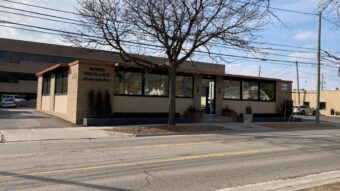Large fitness centers stocked with the latest exercise equipment. Rooftop decks that provide employees with a chance to socialize and brainstorm. Bike storage areas for the growing number of office workers who bike to their jobs. Tenant lounges filled with overstuffed chairs and bathed in the natural light of floor-to-ceiling windows.
These are the amenities you expect in the latest office towers rising from the center of busy cities, right?
Sure. But increasingly, these same amenities are showing up in suburban office properties, said Stephen Wright, principal with the Chicago office of Wright Heerema|Architects.
“The trend we see coming to the suburbs from the city is the amenity explosion,” Wright said.
Wright said that today’s suburban office complexes include the same kind of tenant lounges, conference centers, roof decks a robust fitness centers that modern city office spaces boast. They even come with a wider variety of on-site food options, offering delis and restaurants that cater to a healthier brand of employee.
Offering these amenities makes sense. Companies that want to attract the best employees can no longer afford to skimp on the amenities, even if they are operating from the suburbs. And once they attract these top workers, companies want to keep them healthy and productive, so they’re offering fitness centers that include more than just one or two treadmills in a space the size of a closet.
Wright said that these amenities are playing a role in the health of the Chicago suburban office market. Wright said that while the press might focus on companies moving from the suburbs to the city, the numbers show that office absorption in the Chicago suburbs has actually been stronger during the last several years than it has been in the city proper.
Wright will undoubtedly have more to say about the Chicago suburban office market May 17 at the State of the Suburban Office Market summit held by Illinois Real Estate Journal and REJournals.com. The event, which will feature speakers such as GlenStar’s David Trumpy, NAI Hiffman’s Michael Flynn and JLL’s Andrea Van Gelder, will take place at the Schaumburg Corporate Center in the Chicago suburb of Schaumburg.
For more information about the event or to register, click here.
The new amenities mean that “corporate tenants can offer their employees the lifestyle/workstyle choices they associate with the city without the expense or disruption of moving to the city,” Wright said. “That is not to say that there won’t be more moves to the city, but there are more and more viable and attractive alternatives in the suburbs that will keep many tenants there.”
The myth of the big city
David Trumpy, senior managing director at Chicago’s GlenStar, said that the media are promoting the idea that big companies have fallen in love with the city and are ready to ditch their locations in the suburbs. But Trumpy said that this narrative isn’t true.
“The assumption that all companies are moving downtown is false,” Trumpy said. “People still want to live in the suburbs. The suburbs are still home to a talented workforce. The truth is, when Millennials hit 30, they move to the suburbs. That is the trend.”
Trumpy points to a specific stat to prove this: In the last eight years, several companies have indeed opened office locations in downtown Chicago. But only 6.8 percent of the city’s CBD office leasing activity was made up suburban-based companies moving or opening a location downtown.
“So, it’s really still a small number of companies that are in the suburbs that are moving to downtown,” Trumpy said.
Trumpy said most of the suburban office submarkets across the Chicago area are performing well today. The O’Hare submarket has been especially strong, he said, with office rents here rising by several dollars a square foot in the last 24 months. Trumpy said that there now at least five office properties in this submarket asking for rents of more than $30-a-square-foot gross.
“That submarket is so active right now,” Trumpy said. “We are seeing some real demand for that market.”
Why? It’s location is a strong selling point. It’s easy to get so many locations in the Chicago suburbs from the O’Hare submarket in 20 minutes or less, Trumpy said.The CTA’s Blue Line helps, too. Trumpy said that the O’Hare submarket office properties located within a short walk of the Blue Line tend to have the lowest vacancy rates and highest rents.



